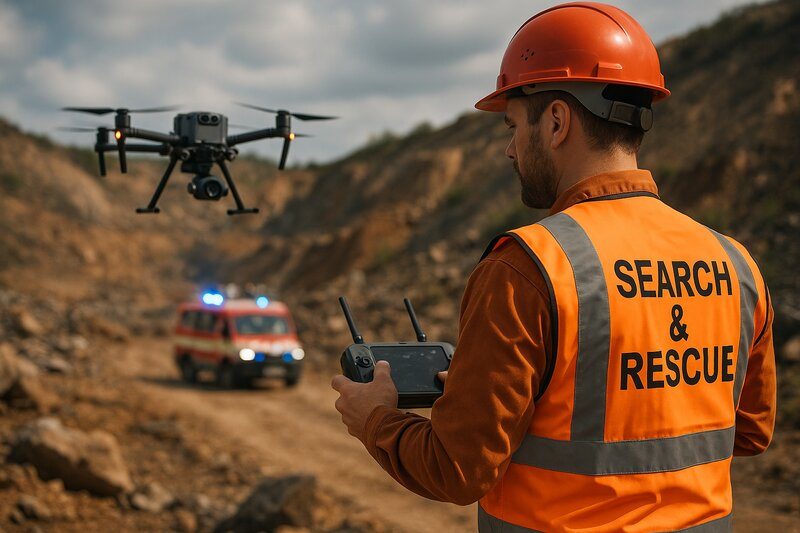Search & Rescue Drone Jobs
When disaster strikes, time is critical. Search & rescue drone jobs are becoming increasingly vital across Australia, providing rapid aerial support during emergency response operations. From locating lost bushwalkers to identifying flood-stranded residents, drones offer a game-changing perspective. But what does a career in this life-saving field really involve? Here’s everything you need to know.

What does a Search & Rescue Drone Operator do?
A search and rescue (SAR) drone operator plays a frontline role in emergency situations. These professionals pilot drones to locate missing persons, assess disaster zones, deliver supplies, and relay critical visual data to on-ground rescue teams. Operators may work alongside police, fire brigades, SES, surf lifesavers, and private emergency response teams.
Drone operators might be deployed in bushfires, floods, missing person searches, maritime rescues, and even urban disasters. Their real-time aerial footage helps inform decisions that can mean the difference between life and death. In many cases, drones are used to scan areas too dangerous or remote for human teams, helping reduce risk to rescuers.
Additionally, drones equipped with speakers and lights can assist in communication and signalling in hard-to-reach areas. In larger operations, SAR drone pilots may be coordinating with helicopters, boats, and emergency vehicles to triangulate locations and deliver accurate intel quickly.
What skills and equipment do you need?
Strong situational awareness, calm under pressure, and excellent piloting skills are essential for this career. You’ll often fly in poor conditions, over tricky terrain, and in high-pressure environments. Good communication with ground teams is crucial, as is quick decision-making. A solid understanding of weather patterns, terrain analysis, and airspace regulations is also necessary.
Key equipment includes:
- DJI M30T or DJI Matrice 300 RTK: Both equipped with thermal sensors and zoom cameras, ideal for spotting heat signatures and long-range searches. They also offer weather-resistant features and are commonly used by emergency services.
- DJI Mavic 3 Thermal: A lighter, more mobile option for rapid deployment with thermal and visual imaging. It is often favoured by small emergency teams or volunteer groups due to its portability and cost-effectiveness.
- Little Ripper drone: An Australian innovation, used in ocean rescues and capable of dropping flotation devices. Wondering how much the Little Ripper drone costs? Prices can vary depending on configuration, but reports suggest they can cost upwards of AUD $50,000. The drone has been credited with saving lives off Australia’s coastline.
Other useful equipment includes thermal imaging payloads, searchlights, spotlights, loudspeakers, and high-capacity batteries for extended flight time. Some drones are also equipped with payload drop systems, allowing life jackets, radios, or medical kits to be delivered to stranded individuals.
What qualifications are required in Australia?
To fly drones commercially in Australia, including for SAR missions, you’ll need a Remote Pilot Licence (RePL). This is issued by CASA and requires both theoretical training and flight assessments. You’ll be trained in aviation law, meteorology, human factors, and operational planning.
If operating under an organisation, they must also hold an Operator’s Certificate (OC). This certificate ensures that operations are carried out safely and legally under CASA oversight. In addition to these, missions that involve flying over or near people (OONP), at night, or in controlled airspace may require additional permissions and risk assessments. Operators need to be familiar with CASA regulations around controlled airspace, restricted zones, and emergency declaration areas.
It is strongly recommended that SAR drone operators stay current with CASA regulations, as rules may change based on advancements in drone technology and public safety concerns. Some SAR teams also require their drone pilots to be trained in first aid, incident command systems, or emergency operations.
Where do you find work in this field?
Search & rescue drone jobs exist in both the public and private sectors. Opportunities include:
- State Emergency Services (SES)
- Surf Life Saving Australia
- Fire and Rescue NSW and equivalents in other states
- Australian Federal Police and local law enforcement
- Private security and emergency contractors
- Local councils with disaster preparedness teams
- Volunteer and non-profit rescue organisations
- Environmental and wildlife monitoring agencies responding to natural disasters
Many drone operators also work freelance, subcontracting during emergency events or partnering with media and insurance companies to assess disaster damage. Networking with industry bodies such as ARPAS or joining search and rescue networks can also help uncover job leads.
How much can you earn as a Search & Rescue Drone Operator?
Rates vary widely depending on experience, deployment type, and employer. Experienced contractors may earn AUD $1000+ per day during large-scale emergency events, particularly if they own and operate their own high-end equipment. Salaried roles in government departments or not-for-profits may be closer to AUD $70,000–$100,000 annually.
Some operators also supplement their income with drone training, consultancy, or post-processing services (such as orthomosaic mapping or video editing for news media). Those who specialise in thermal drone operation or have additional skills (like paramedic or emergency response training) can command premium rates.
Career progression & related paths
Many SAR drone operators branch into:
- Disaster mapping and aerial surveying
- Emergency management and coordination
- Media and news drone coverage of crisis zones
- Training others in drone SAR operations
- Developing drone-based emergency response technology and apps
- Search and rescue logistics and planning roles
Some also move into airspace coordination, drone fleet management, or consulting for organisations needing drone integration for safety and surveillance. Opportunities for career advancement grow with cross-training, equipment upgrades, and participation in multi-agency response drills.
Pros and cons of the job
Pros:
- Highly rewarding, life-saving work
- Opportunity to work in high-stakes, real-world scenarios
- Variety in job locations and missions
- Rapidly growing field with new tech emerging
Cons:
- Irregular work depending on emergencies
- Emotionally taxing situations
- Must operate under strict safety and legal protocols
- Requires ongoing investment in training and equipment
How to get started as a Search & Rescue Drone Operator today
Your first step is to get your RePL with Flying Glass. From there, seek out volunteer or training opportunities with local emergency groups or SES. Build hours on your thermal-capable drone, and document real-world flying conditions in your logbook. Create a portfolio of past missions or practice flights that show your capability in search and rescue environments.
Consider also upskilling in first aid, emergency response protocols, and mapping software like Pix4D or DroneDeploy. Joining drone or SAR communities online and offline can open doors to future deployments. Attending emergency response expos or CASA safety seminars can also help with networking and industry knowledge.
Case study: Drones in Queensland Flood Rescue
During the 2022 Queensland floods, thermal drones were deployed by both government agencies and private drone teams to identify trapped individuals and deliver supplies. The use of drones dramatically reduced response time and ensured safer, quicker rescues in areas unreachable by road. In one instance, a DJI Matrice drone located a family stranded on a roof in Gympie, directing boats to the exact location.
In another case, volunteers flying search and rescue drones in Lismore helped SES coordinate rescue missions when phone reception and traditional comms were down. Their ability to upload live feeds directly to command centres transformed how resources were allocated in real time.
This Post is part of our Drone Jobs Series

